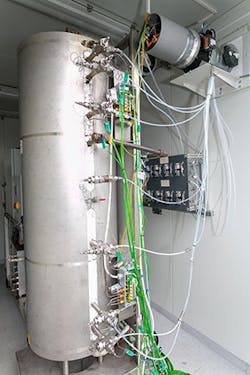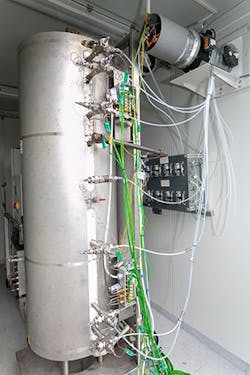High Purity Hydrogen Generator Passes Milestone
Figure 1. Unit at Mureck demonstration plant has successfully produced high purity hydrogen.
A demonstration plant to produce high purity hydrogen from biogas via a chemical looping (CL) process developed by Austrian researchers successfully completed its first run in October. The plant was built by the Technical University (TU) Graz, Austria, and Rouge H2 Engineering, Graz, at the latter’s site in Mureck, Austria.
The 10-kW plant diverts about 1% — roughly 30 L/min — of its biogas flow. This is mixed with steam and sent into the plant’s reactor. There, reforming of the biogas produces syngas used to reduce iron oxide to iron. Steam then enters the reactor, reoxidizing the iron back to iron oxide and releasing 99.998%-pure hydrogen. The iron/steam process achieved 75% efficiency.
Channelling the entire 480-m3/hr biogas from Mureck through a correspondingly scaled-up CL plant would result in a 3-MW hydrogen production plant, note the researchers. “This means the technology is now ready for commercial use. We can also produce decentralized hydrogen from real biogas on a large scale. All it needs is a little space for our plant,” emphasizes Rouge H2 project manager, Gernot Voitic. The cost of hydrogen production is competitive with other manufacturing routes, he adds.
Meanwhile, Viktor Hacker, head of the Institute for Chemical Engineering and Environmental Technology at TU Graz, is heading a three-year project to improve the service life of the iron-based material used in the reactor.
“It currently supports a few hundred cycles. We hope to improve this lifetime to several thousands of cycles in the next one-to-two years,” he explains.
The team particularly is investigating mixed ion-electron conductors (MIECs), says Hacker: “As we employ a solid-gas conversion, we have to focus on the exchange capacity in our materials. For this reason, in contrast to catalytic processes, we need to increase the exchange capacity of our materials. Thus, the focus is laid on an inexpensive production process, the use of harmless solvents, and environmentally friendly materials. If we can reduce the conversion time by 50%, it would be a great success for the project.”
At the same time, the synthesis and characterization of new cost-efficient, non-toxic and economically favorable redox materials in combination with the support structure also could have applications such as catalysts and in similar high-temperature processes and catalytic materials.
“We will investigate and test the applicability of our oxygen carriers for other CL technologies in parallel projects. Furthermore, we will build up expertise in material research for other processes where high-temperature oxygen transfer may be required,” Hacker concludes.

